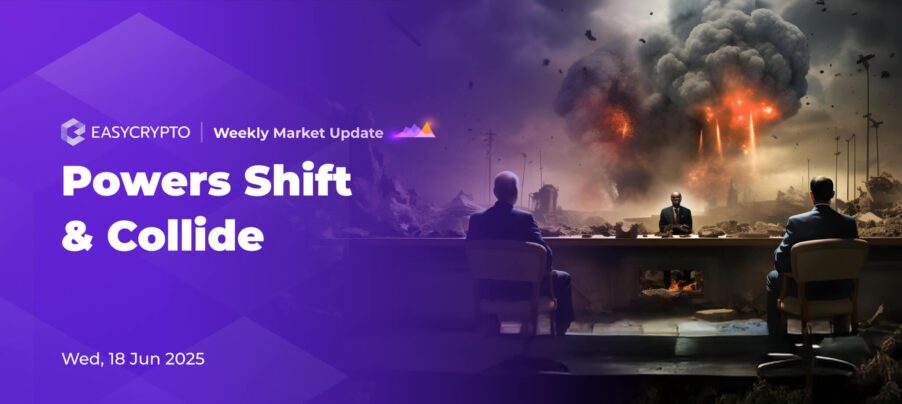How U.S. Economic Policies Affect the Crypto Market
In this news update, we’re going to reflect on how the crypto market has responded to changes in US central bank policy.
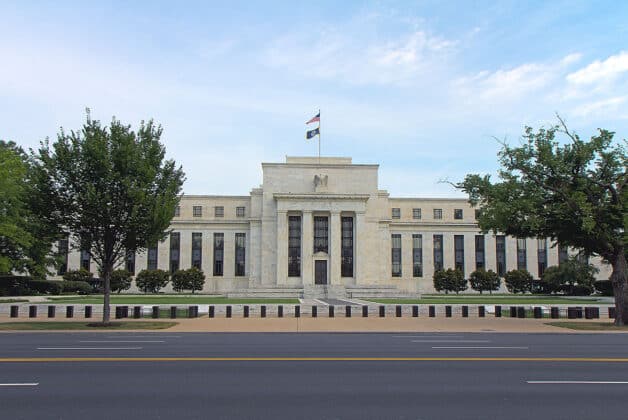

Economic policies around the world have been responsible for moving the crypto market to a certain degree. The influence of policy is greater in major economies like China and the United States.
We are especially interested in how US economic policies affect the crypto market. This is because the US is one of the places that are most friendly to innovative tech business. Many major exchanges and blockchain-based start-ups have their roots in the United States.
In this news update, we’re going to reflect on how the crypto market has responded to changes in US central bank policy.
How the Fed Tapering Policy affects the crypto market
Since the coronavirus pandemic began, the US Federal Reserve System (also known as “The Fed”) has been buying bonds and securities from the US financial market. This is part of a programme known as quantitative easing, with the goal of stimulating the US economy.
Another part of this programme is to distribute stimulus checks and sell Treasury bonds — essentially printing out new money into the economy. Many economists have suggested that the subsequent surge in the stock market, followed by the crypto market, was caused in part by quantitative easing.
“There’s clearly a correlation between COVID-19 and people being reengaged with their money,” according to Bill Parsons, Data Analytics at Envestnet Yodlee, in a CNBC report.
However, this economy-stimulating gas pedal must be released at some point. The Fed’s monetary-policy committee announced that the quantitative easing programme has “continued to contribute to elevated levels of inflation.”
Tapering refers to the slowing down of the quantitative easing programme. Many investors and traders have feared that an overly aggressive tapering will negatively impact the general market as a whole. Just almost a week ago, the Fed’s committees assembled to discuss the extent of the tapering.
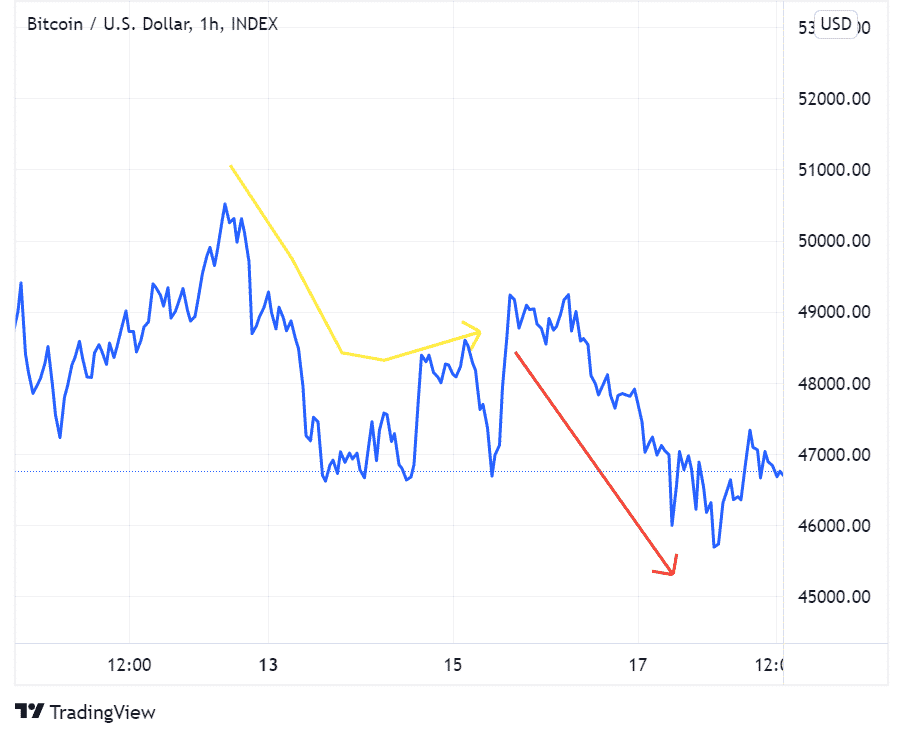
The yellow line on the Bitcoin price chart shows an increasingly bearish outlook on Bitcoin after the 4 December crash. Traders “waited patiently” during this time, as the date approaches 15 December.
Then came the announcement. The Fed will reduce its bond purchases by $30 billion every month, which is twice the previous rate of tapering. The red line shown in the chart above is led by a continued price decrease, as traders expected nothing more of this inevitable news.
Understand deeper: Bitcoin’s scarcity and value proposition.
Is this the end of the crypto bull run?
Although the Fed’s stimulus programme will end sooner than expected, long-term investors shouldn’t forget the lasting complicated side effects of quantitative easing.
On one hand, the inevitable effects of inflation would dilute the US dollar, making cryptocurrencies more attractive to hold for the long term. In the short term though, tightening monetary policy will likely decrease the purchasing power of investors.
In terms of price action, it’s possible that we would have an extended consolidation period, in which crypto prices will move “sideways” within a narrow range.
We will have to experience this to know for sure. The last time the Fed has used quantitative easing was in 2008, after the stock market crash. This was the financial meltdown that triggered the creation of Bitcoin — and things were different for the cryptocurrency back then.
Will crypto ever die? When crypto is more than just an investment, it won’t.
Why the crypto market moves with the news
News is often the greatest driver for mass buying and selling behaviours. Short-term movements have more to do with anticipation and speculation on the effects of policies, rather than the real effect felt afterwards.
For example, when Tesla announced that they’ve purchased over $1.5 billion in bitcoin on 8 February 2021, the market reacted by breaking the “flag pattern” (1) and continued its rally from that point on (2).
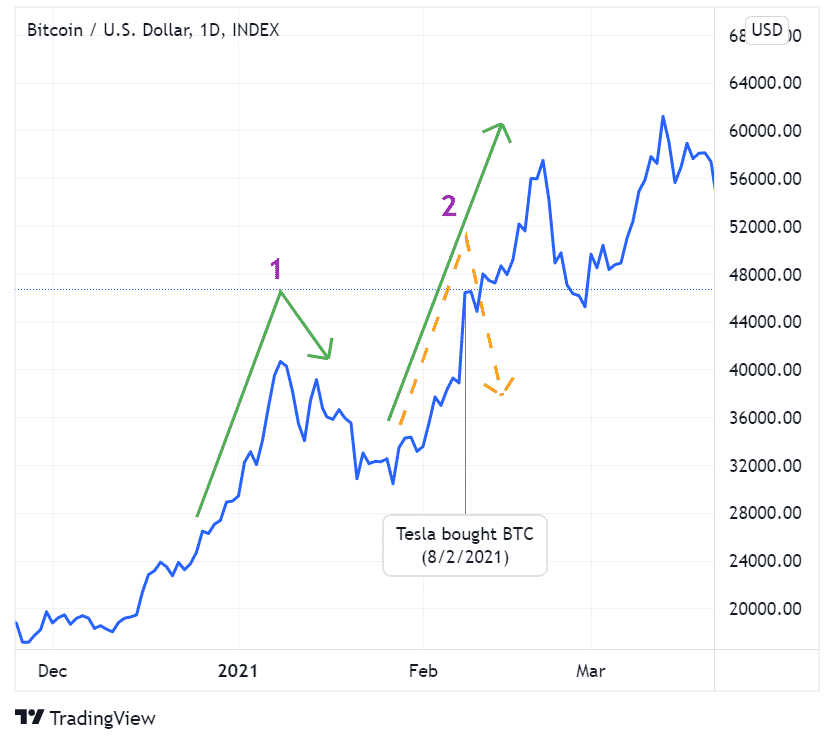
Investors were in full faith that cryptocurrencies could become America’s second best medium of exchange. As we know, Tesla declined to accept Bitcoin as payment in late spring, citing environmental concerns.
The environmental issue with Bitcoin mining is old news. However, speculation on its potential use for business has made short-term investors excited.
Although the operation of crypto networks remains decentralised, the crypto market activity is not isolated from macroeconomic factors. This is because cryptocurrencies are becoming legitimate investment vehicles for peoples of all walks of life.
This means various people will react to news differently. On 4 December 2021, the property developer giant Evergrande officially defaulted. This means that the company is not able to completely repay its $300 billion debt to various financial institutions.
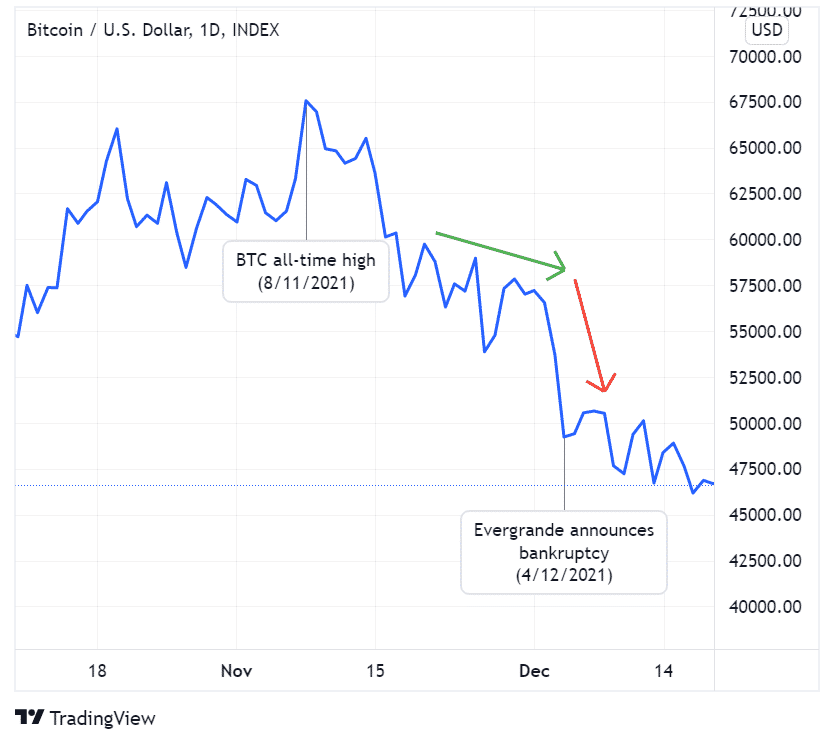
At least one of these financial institutions has been exposed to cryptocurrencies. Upon this news, financial institutions may let go of risky assets like cryptocurrencies in order to protect their balance sheets.
Thus, a large sell-off occurred. Financial institutions have the ability to move large amounts of money to and from the crypto market.
Related: Credit Card Giants in Crypto — Opportunity or Threat?
Why China hasn’t affected the crypto market recently
Although China is one of the world’s economic superpowers, its policy towards crypto has been hostile for a long time. The effects of their stance has been “priced in”, meaning that the current crypto market prices have already reflected this.
In the past few months, no amount of negative news from the country could shake the market. However, should China surprisingly alleviate its ban on cryptocurrencies, we would expect a massive rally following the news.
Before the total ban on cryptocurrencies in China, the country’s policy has moved the market in some significant ways. Crypto mining activities used to be somewhat centralised around China.
Due to Beijing’s crackdown on crypto mining and ban on exchanges, massive selling pressure was felt around summer 2021. Not to mention, it has been difficult for populations of mainland China to invest and trade cryptocurrencies.
Now with the majority of crypto mining operations moving into the United States, American lawmakers are shrouded with more influence over the crypto market than ever before.
Share to
Stay curious and informed
Your info will be handled according to our Privacy Policy.
Make sure to follow our Twitter, Instagram, and YouTube channel to stay up-to-date with Easy Crypto!
Also, don’t forget to subscribe to our monthly newsletter to have the latest crypto insights, news, and updates delivered to our inbox.
Disclaimer: Information is current as at the date of publication. This is general information only and is not intended to be advice. Crypto is volatile, carries risk and the value can go up and down. Past performance is not an indicator of future returns. Please do your own research.
Last updated October 18, 2022



